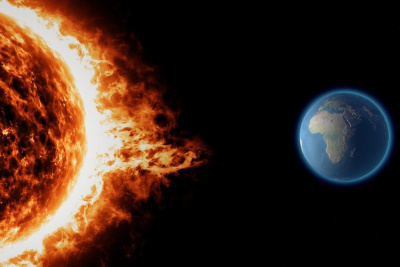Strong magnetic storm hits the planet: storm will last for two days in a row
4 June 2024 11:02
Today, on 4 June, the Earth was covered by another magnetic storm that will last for two days. This is evidenced by the data of the Space Weather Prediction Centre of the National Oceanic and Atmospheric Administration of the United States and the Meteoagent resource, "Komersant Ukrainian" reports
The storm is reported to be the result of a double X1-M7 solar flare.
A coronal mass ejection was launched into space on 1 June by a complex X1-M7 double solar flare, confusing astroforecasters. At the same time, 2 CMEs were released from the Sun, one of which was directed towards our planet and the other away from the Earth.
It should be noted that geomagnetic storms are classified by their power level – the K-index – from 2 to 9. The geomagnetic activity of this storm will correspond to K-index 5.
“The higher the K-index, the stronger the storm and its consequences and impact on people and equipment,”
– the Centre explains.

Scientists report that the minimum solar activity will last until 8 June, but a small geomagnetic storm of 4 points is expected on Sunday, 9 June.
In particular, according to the Space Weather Prediction Centre, the following periods of radiomagnetic activity are expected during the month:
- 8-12 June: a weak storm;
- 16-22 June: a storm of medium power;
- 23 June: a strong storm;
- 28-30 June: strong storm.
Magnetic storms
Magnetic storms are temporary disturbances of the Earth’s magnetic field caused by solar activity bursts, such as coronal mass ejections or solar flares. They occur when powerful emissions of charged particles (plasma) from the Sun interact with the Earth’s magnetosphere. These solar plasma streams can change the shape and direction of the Earth’s magnetic field, causing disturbances and magnetic storms.
Magnetic storms are classified according to their intensity – from G1 (weakest) to G5 (strongest). Severe magnetic storms (G3 and above) can cause problems in power grids, communication systems, satellite operations and even aviation. Space agencies such as NOAA and NASA monitor solar activity and forecast potential magnetic storms, which allows them to take precautionary measures.
During magnetic storms, solar plasma particles interact with the upper layers of the Earth’s atmosphere, resulting in the formation of bright northern lights at high latitudes.
Health hazards
Magnetic storms are natural phenomena associated with solar activity, and although they rarely pose a serious risk, it is important to understand their impact.
Magnetic storms do not pose a serious health risk to most people. However, some studies indicate that mild disorders such as headaches, dizziness, insomnia, or poor health may occur during strong magnetic storms in meteorologically sensitive people.
To reduce the potential impact of magnetic storms, it is recommended to follow these tips
- avoid excessive outdoor exposure during the peak moments of the storm;
- limit physical activity;
- get plenty of rest;
- drink plenty of fluids;
- avoid stressful situations.
People with serious chronic illnesses should consult a doctor about additional precautions during strong magnetic storms.









